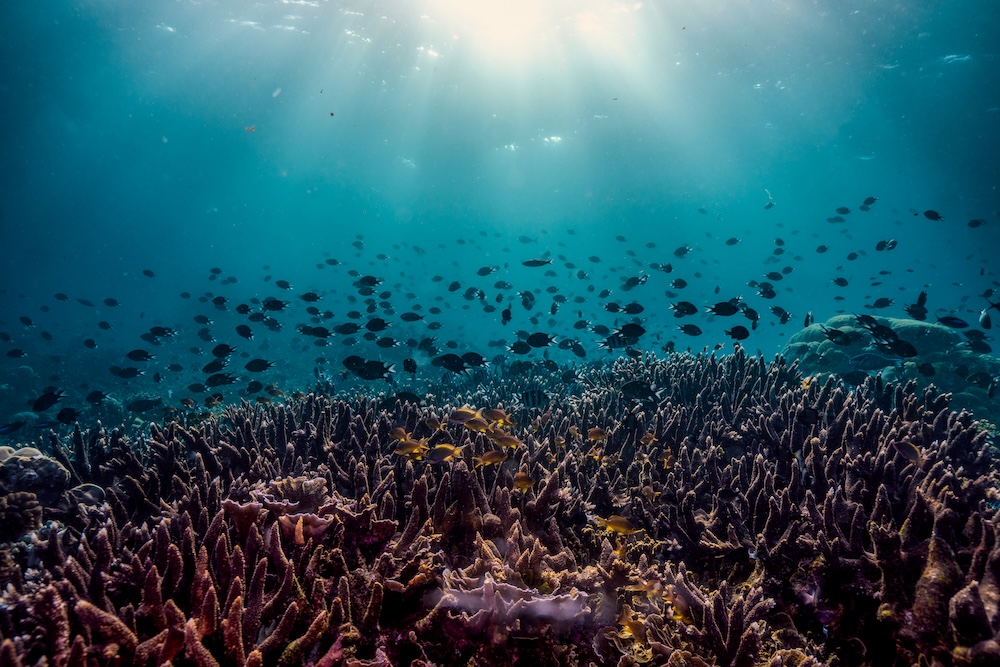When oil spills reach the ocean, the first images we see are slicks on the surface and birds coated in tar. What often goes unseen is what happens beneath the waves — to coral reefs. These ecosystems, home to a quarter of marine life, don’t just get smothered externally by oil. They actually absorb hydrocarbons deep into their tissues and root-like skeletons. Once oil enters a coral reef, it doesn’t just wash away. It lingers, weakening the reef from within.
Why Coral Reefs Are So Vulnerable
Coral reefs are living organisms made of tiny animals called polyps. These polyps secrete calcium carbonate skeletons that form reef structures. Unlike rocky surfaces, corals are porous and biologically active, meaning oil doesn’t just sit on top — it penetrates.
- Corals feed by filtering water, so they actively draw in toxins.
- Their tissues store hydrocarbons that interfere with growth and reproduction.
- Their skeletons and root-like base structures trap oil, creating long-term contamination.
This makes oil spills a double blow: corals are smothered externally and poisoned internally.
How Oil Enters Coral Roots and Tissues
Research has shown that oil droplets and dissolved hydrocarbons enter coral through multiple pathways.
- Contact with surface slicks damages coral mucus layers, the first line of defense.
- Dissolved compounds in the water column enter coral polyps during feeding.
- Oil particles bind to sediments, which corals inadvertently trap in their base structures.
Once hydrocarbons reach coral tissue, they disrupt photosynthesis in symbiotic algae (zooxanthellae) that provide energy to the reef. Without this symbiosis, corals bleach, weaken, and often die.
The Ripple Effects of Oil in Coral
The damage is not confined to corals alone.
- Fish nurseries collapse when reefs degrade, since reefs are breeding grounds.
- Shellfish and crustaceans lose habitat and food sources.
- Coastal communities that rely on coral reefs for fishing and tourism face economic collapse.
- Entire marine food webs unravel when reef ecosystems disappear.
Oil in coral is not just an environmental tragedy — it’s a social and economic disaster.
Case Studies
Deepwater Horizon, Gulf of Mexico (2010): Oil spread far below the surface, coating and penetrating deepwater corals. Many colonies suffered long-term tissue damage, slowed growth, and partial mortality years after the spill.
Mauritius (2020): When a Japanese tanker leaked oil near coral lagoons, polyps absorbed hydrocarbons almost immediately. Scientists recorded bleaching and mortality in just weeks.
Red Sea studies: Experiments show even low-level chronic exposure leads to reduced calcification and reproductive failure in corals, even when slicks are not visible.
Why Recovery Is So Hard
Unlike sandy beaches, which can sometimes be cleaned, corals cannot shed oil once it’s absorbed.
- Hydrocarbons linger in tissues for years.
- Coral growth slows dramatically, weakening reef resilience.
- Reproductive success drops, meaning fewer new corals to replace the lost ones.
- Oil trapped in skeletons can re-release toxins into surrounding water long after a spill.
This means oil contamination can cripple a reef for decades.
Can Corals Survive Oil Spills?
Some corals show resilience, but survival depends on spill size, timing, and response.
- Shallow reefs in warm, nutrient-rich waters may bounce back more quickly if spill cleanup is rapid.
- Deepwater corals, where light is limited and recovery is slow, are especially vulnerable.
- Even resilient corals often show sublethal effects — slower growth, reduced fertility, and higher vulnerability to bleaching.
Recovery is possible, but rarely full.
Prevention Is the Only Real Solution
Because reefs can’t be “cleaned” once oil penetrates them, prevention is critical.
- Stronger regulations for shipping near coral reef regions.
- Bans on offshore drilling in reef-rich areas.
- Improved spill response plans that prioritize coral ecosystems.
- Global transition away from oil dependency.
Without prevention, spills will continue to erase coral ecosystems that have taken millennia to form.
What You Can Do
- Support renewable energy to reduce demand for oil transport and drilling.
- Back conservation groups fighting for reef protections.
- Reduce personal plastic and petroleum consumption, which drives oil extraction.
- Stay informed and share the hidden story of corals absorbing oil — awareness can shift policy.
FAQs
How does oil poisoning differ from coral bleaching due to climate change?
Both disrupt the coral-algae symbiosis. Bleaching from heat stress expels algae; oil poisoning disrupts photosynthesis and damages tissue directly. Together, they compound the threat.
Do dispersants help protect reefs during spills?
Often not. Dispersants can break oil into smaller droplets, but those droplets are more easily absorbed by corals, worsening contamination.
How long can oil stay in a coral reef?
Studies have shown hydrocarbons persisting in coral tissues and skeletons for years to decades.
Are some coral species more resistant than others?
Yes, massive corals with thick tissues may withstand exposure better than delicate branching corals, but no reef species is immune.
Final Thoughts
Coral reefs are living fortresses of biodiversity, but they are also fragile filters that absorb everything in their waters. When oil spills occur, they don’t just stain the surface — they seep into the very roots of coral ecosystems, weakening them from the inside out.
For reefs already under siege from climate change, overfishing, and acidification, oil spills may be the final blow. The truth is stark: oil and coral cannot coexist. Every barrel spilled in reef waters erases centuries of growth and life.
Protecting coral reefs means more than cleaning up after disaster. It means preventing oil from ever reaching them — and ultimately ending our dependence on the fossil fuels that keep putting them at risk.









Reader Interactions